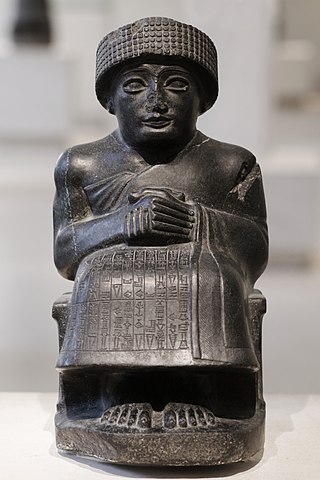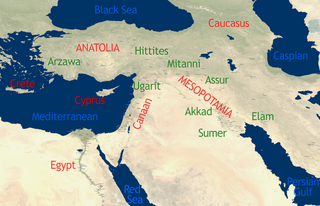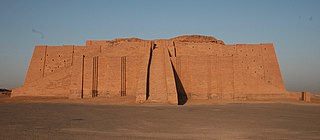
The Akkadian Empire was the first known ancient empire of Mesopotamia, succeeding the long-lived civilization of Sumer. Centered on the city of Akkad and its surrounding region, the empire would unite Akkadian and Sumerian speakers under one rule and exercised significant influence across Mesopotamia, the Levant, and Anatolia, sending military expeditions as far south as Dilmun and Magan in the Arabian Peninsula.
The 3rd millennium BC spanned the years 3000 to 2001 BC. This period of time corresponds to the Early to Middle Bronze Age, characterized by the early empires in the Ancient Near East. In Ancient Egypt, the Early Dynastic Period is followed by the Old Kingdom. In Mesopotamia, the Early Dynastic Period is followed by the Akkadian Empire. In what is now Northwest India and Pakistan, the Indus Valley civilization developed a state society.
The 23rd century BC was a century that lasted from the year 2300 BC to 2201 BC.

Sumer is the earliest known civilization, located in the historical region of southern Mesopotamia, emerging during the Chalcolithic and early Bronze Ages between the sixth and fifth millennium BC. Like nearby Elam, it is one of the cradles of civilization, along with Egypt, the Indus Valley, the Erligang culture of the Yellow River valley, Caral-Supe, and Mesoamerica. Living along the valleys of the Tigris and Euphrates rivers, Sumerian farmers grew an abundance of grain and other crops, a surplus which enabled them to form urban settlements. The world's earliest known texts come from the Sumerian cities of Uruk and Jemdet Nasr, and date to between c. 3350 – c. 2500 BC, following a period of proto-writing c. 4000 – c. 2500 BC.
The 26th century BCE was a century that lasted from the year 2600 BCE to 2501 BCE.

The history of Sumer spans the 5th to 3rd millennia BCE in southern Mesopotamia, and is taken to include the prehistoric Ubaid and Uruk periods. Sumer was the region's earliest known civilization and ended with the downfall of the Third Dynasty of Ur around 2004 BCE. It was followed by a transitional period of Amorite states before the rise of Babylonia in the 18th century BCE.
Lagash was an ancient city state located northwest of the junction of the Euphrates and Tigris rivers and east of Uruk, about 22 kilometres (14 mi) east of the modern town of Al-Shatrah, Iraq. Lagash was one of the oldest cities of the Ancient Near East. The ancient site of Nina is around 10 km (6.2 mi) away and marks the southern limit of the state. Nearby Girsu, about 25 km (16 mi) northwest of Lagash, was the religious center of the Lagash state. The Lagash state's main temple was the E-ninnu at Girsu, dedicated to the god Ningirsu. The Lagash state incorporated the ancient cities of Lagash, Girsu, Nina.

Gudea (Sumerian: 𒅗𒌤𒀀, Gu3-de2-a) was a ruler (ensi) of the state of Lagash in Southern Mesopotamia, who ruled c. 2080–2060 BC (short chronology) or 2144–2124 BC (middle chronology). He probably did not come from the city, but had married Ninalla, daughter of the ruler Ur-Baba (2164–2144 BC) of Lagash, thus gaining entrance to the royal house of Lagash. He was succeeded by his son Ur-Ningirsu. Gudea ruled at a time when the center of Sumer was ruled by the Gutian dynasty, and when Ishtup-Ilum ruled to the north in Mari. Under Gudea, Lagash had a golden age, and seemed to enjoy a high level of independence from the Gutians.

The Third Dynasty of Ur, also called the Neo-Sumerian Empire, refers to a 22nd to 21st century BC Sumerian ruling dynasty based in the city of Ur and a short-lived territorial-political state which some historians consider to have been a nascent empire.

The history of Mesopotamia ranges from the earliest human occupation in the Paleolithic period up to Late antiquity. This history is pieced together from evidence retrieved from archaeological excavations and, after the introduction of writing in the late 4th millennium BC, an increasing amount of historical sources. While in the Paleolithic and early Neolithic periods only parts of Upper Mesopotamia were occupied, the southern alluvium was settled during the late Neolithic period. Mesopotamia has been home to many of the oldest major civilizations, entering history from the Early Bronze Age, for which reason it is often called a cradle of civilization.

Ensi was a Sumerian title designating the ruler or prince of a city-state. Originally it may have designated an independent ruler, but in later periods the title presupposed subordinance to a lugal.

The Awan Dynasty was the first dynasty of Elam of which very little of anything is known today, appearing at the dawn of historical record. The Dynasty corresponds to the early part of the Old Elamite period, it was succeeded by the Shimashki Dynasty and later the Sukkalmah Dynasty. The Elamites were likely major rivals of neighboring Sumer from remotest antiquity; they were said to have been defeated by Enmebaragesi of Kish, who is the earliest archaeologically attested Sumerian king, as well as by a later monarch, Eannatum I of Lagash.

The Early Dynastic period is an archaeological culture in Mesopotamia that is generally dated to c. 2900 – c. 2350 BC and was preceded by the Uruk and Jemdet Nasr periods. It saw the development of writing and the formation of the first cities and states. The ED itself was characterized by the existence of multiple city-states: small states with a relatively simple structure that developed and solidified over time. This development ultimately led to the unification of much of Mesopotamia under the rule of Sargon, the first monarch of the Akkadian Empire. Despite this political fragmentation, the ED city-states shared a relatively homogeneous material culture. Sumerian cities such as Uruk, Ur, Lagash, Umma, and Nippur located in Lower Mesopotamia were very powerful and influential. To the north and west stretched states centered on cities such as Kish, Mari, Nagar, and Ebla.

The chronology of the ancient Near East is a framework of dates for various events, rulers and dynasties. Historical inscriptions and texts customarily record events in terms of a succession of officials or rulers: "in the year X of king Y". Comparing many records pieces together a relative chronology relating dates in cities over a wide area.

Neo-Sumerian art is a period in the art of Mesopotamia made during the Third Dynasty of Ur or Neo-Sumerian period, c. 2112 BC – c. 2004 BC, in Southern Mesopotamia. It is known mostly for the revival of the Sumerian stylistic qualities and was centered around royalty and divinity.

Ur-Baba or Ur-Bau (Sumerian: 𒌨𒀭𒁀𒌑ur-Dba.ba6 or ur-Dba.U2, servant of the goddess Bau) was ensi of Lagash from 2093 BC – 2080 BC (short chronology) or 2157 BC – 2144 BC (middle chronology), roughly contemporaneous with the last king of Akkad, Shu-turul. In one of his inscriptions, he refers to himself as a child of the god Ninagal (Sumerian: 𒀭𒎏𒀉𒃲).

Ur-Ningirsu also Ur-Ningirsu II in contrast with the earlier Ur-Ningirsu I, was a Sumerian ruler (ensi) of the state of Lagash in Southern Mesopotamia who ruled c. 2110 BC. He was the son of the previous ruler of Lagash named Gudea.
Ur-Ningirsu I, was a Sumerian ruler (ensi) of the state of Lagash in Southern Mesopotamia who ruled c. 2200 BCE. He is much less known and documented than Ur-Ningirsu II, generally just called Ur-Ningirsu.
Pirig-me, was a Sumerian ruler (ensi) of the state of Lagash in Southern Mesopotamia who ruled c. 2200 BCE. He was the son of Ur-Ningirsu I.

The Renaissance of Sumer is a period of the history of Mesopotamia that includes the years between the fall of the Akkadian Empire and the period of the Amorite dynasties of Isin and Larsa—both with governments of Semitic origin—between the centuries 22nd B.C. and 21st B.C. Within this stage the years of the so-called Third Dynasty of Ur or "Ur III" stand out, because of the new hegemony that would embrace all Mesopotamia, this time with the city of Ur at the head.













